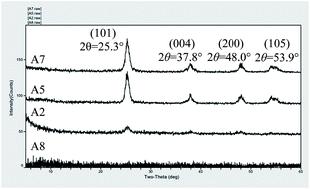Orthogonal experimentation for optimization of TiO2 nanoparticles hydrothermal synthesis and photocatalytic property of a TiO2/concrete composite
Abstract
An orthogonal experimental design was applied to optimize the hydrothermal preparation parameters of TiO2 nanoparticles by the analysis of means (ANOM) and variances (ANOVA). The ANOM & ANOVA results on crystalline and size show that the optimal process of synthesized TiO2 nanoparticles is 5.0% TBT, an alkalescent environment (pH = 9), 160 °C reaction temperature, and 3 h reaction time. The main factors affecting the photocatalytic properties of TiO2 nanoparticles were explored by measuring the UV light absorbance index, and the results show that their photocatalytic performance are excellent when methyl orange (MeO) concentration is 2.5 mg L−1, the pH value is 6, and the Ag-doped amount is 5.0%. Then optimal TiO2 nanoparticles aqueous suspensions with varied concentration (cTiO2) were sprayed on permeable concrete to fabricate TiO2/concrete composites, and their photocatalytic activity was evaluated by measuring the degradation rate of soaked MeO along the UV radiation time. It is concluded that when cTiO2 is 2.0 g L−1 with above fixed conditions, the produced TiO2/concrete composite has an optimal capacity (35.7%) in the photo-degradation of azo pollutants.


 Please wait while we load your content...
Please wait while we load your content...